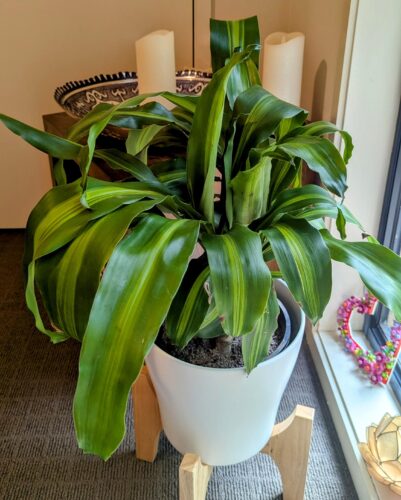I was reading a magazine this week which briefly mentioned ‘glimmers’.
Then this morning I saw a friend had shared something on social media about the same thing.
A glimmer is a small moment of joy or happiness.
The delight at spotting a rainbow.
Feeling the sun kiss your skin.
Seeing a picture of your pet.
The smell of your favourite flower or candle.
It’s just a micro-moment, something that makes you smile.
A spark of realisation, rather than an explosion of light.
For example, today was rather miserable and wet outside, but I looked at my so called ‘Happy Plant’ in my meditation room, and just the very name of it made me smile.

A glimmer is also the opposite of a trigger.
A trigger tends to agitate the sympathetic nervous system – the fight or flight response in your body.
It can create negative feelings, such as anxiety, stress, sadness, fear or anger.
Triggers increase the heart rate and blood pressure, putting you on high alert.
Clearly it’s not healthy to be in this state for long periods of time.
Identifying glimmers can help you regulate this, by stimulating the parasympathetic system (the rest and digest response).
A lot has been written about glimmers since the term was popularised on TikTok in 2022.
But the expression was first used in 2018 by Deb Dana, a clinician who specialises in complex trauma.
This itself came out of Polyvagal Theory, first introduced by Stephen Porges in the mid-90s.
According to the Polyvagal Institute the theory emphasises the role the autonomic nervous system – especially the vagus nerve – plays in regulating your health and behavior.
It searches for and interprets things, people and environments, to determine whether or not they’re a threat.
The practice of noticing and appreciating glimmers can cue your nervous system to relax and, over time, have a positive effect on your mental health.
Essentially, glimmers can help to regulate an overwhelmed nervous system.
So how do you become more aware of these glimmers?
One of the simplest ways is to practice mindfulness.
To notice glimmers, bring your attention to your senses of vision, hearing, taste, smell and touch.
Being aware of what’s good around you – right now – in this present moment.
Flat out at work and against deadline?
Hearing laughter elsewhere and allowing yourself to smile.
Or taking a brief moment to look at the photo of someone you love on your desk.
Stuck at a traffic light and in a hurry for an appointment?
Turn on the radio and sing like no-one is listening.
Having a rough day, or feeling down?
Step outside and listen to a bird giving it their all.
Or noticing what’s in flower and the colours around you.
Start small – noticing one glimmer a day.
Open yourself up to the notion there’s a glimmer of hope somewhere.
You will soon start spotting them everywhere…
Ann 🙏
